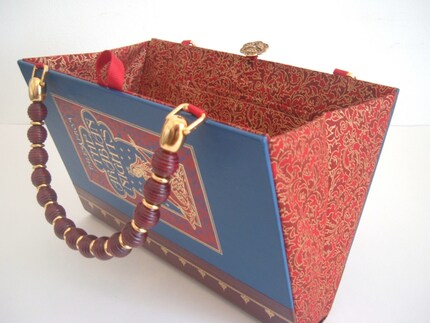May 4, 2009
The Toronto Book Fair and Paper Show
Despite the baby and I being sick with a nasty (un-swine-related) flu, my family and I bustled off bright and early yesterday morning to the Spring Toronto Book Fair and Paper Show in the St. Lawrence Market. After 24 hours of reflection on the event I am now prepared to declare it a sad little affair which is, I suspect, staggering towards its ultimate demise.
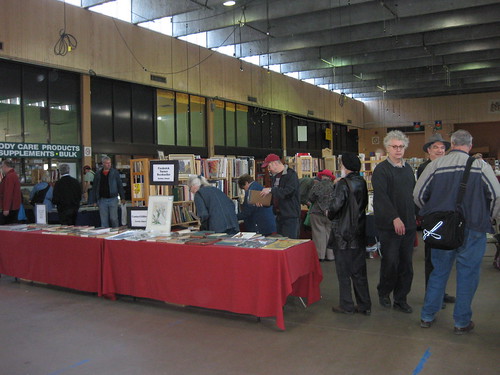
The May 2009 Toronto Book Fair and Paper Show
1. First Impressions Last: I’ll begin on the outside and work my way in. We approached the market building to find the usual Sunday Antiques market in full and lively swing. It was a beautiful day and the colourful booths were busy and full of tourists and collectors. This, however, was not the Book Fair. After some searching we fought our way to the front door of 92 Front St. proper, finding it lamely signed with an 8 x 11″ print out announcing the event within. Passing from the sunny, bustling out-of-doors into the cool, dank and deserted room was sobering and not a little frightening.
2. Show us the money: I don’t begrudge any organization their fees, because I understand that all events have costs associated with them. But what, exactly, has Heritage Antique Shows been doing with theirs? $7 per person is a moderate entry fee, but other than rental of the space, I fail to see what Heritage contributed to the show. Pre-advertising was nonexistent, limited, as far as I could tell, to their vintage 1998-style poster board website and fliers being distributed at the door (why do I need a flier for an event I am already at?). The website is limited and unprofessional. Nothing was done to the hall except to provide bare tables for the vendors. The “snack bar” seemed to be running on rations – there was something especially pathetic about reading a specials board which lists the Soup of the Day as “NO SOUP”.
By comparison, the New York Antiquarian Book Fair costs $20 to get in, but takes place at the Park Avenue Armory, issues its own catalogue, provides a floor plan, map and guide to the guests, has a beautiful, functional website, is warmly and tastefully decorated for the event and hosts private events during the show. I don’t ask Toronto’s show to rival the “Best in the World”, but surely they can provide something other than a dark hovel for book gnomes to sniff and scratch books in.
3. This isn’t thirty years ago: The draw of a book fair used to be in part the opportunity to see the wares of out-of-town book dealers, as well as those dealers who keep a closed shop. But alas, this is the age of Abebooks.com, and the stock of unseen vendors is no longer a big undiscovered mystery. If you are going to ask book collectors to come out and see your wares, you need to show them something they didn’t see 45 minutes earlier online. What might that be? Oh, I don’t know. Debut some new finds. Offer show specials and discounts. Mini-raffles. Free appraisals. ANYTHING.
This is probably a big part of why the busiest aspect of the show by far was the “Paper” part. Postcards, prints, maps and various ephemera were getting a lot of attention. Well – there’s no Abepostcards.com yet! Paper collectors still have a reason to come out and root through boxes and binders. Book collectors – not so much.
4. Retiring Attendees: I passed quite a few people having hushed conversations about the attendance. Attendance is down again, always declining. Not just on the customer side either – it looks as if dealers are opting not to come show either. The site was looking barren. The fewer people show up, the fewer dealers show up, and so on. I’m willing to cast stones in all directions on this one. The attendees on both sides of the glass were as antique as the books. With dealers shutting doors left right and centre, they don’t seem over-eager to participate in an exercise in self-promotion like a Book Fair. Many booksellers are quietly fading into semi-retirement, relying on their existing customer bases to keep them company until they finish. Customers, on the other hand, are dying off quicker than new ones are born. There may be a way or a venue for younger, more forward-thinking dealers and collectors to gather, but this wasn’t it.
5. But it wasn’t all bad…: Okay, there were a few good things about the event. It was lovely to see all the local books, the Canadiana on display. Lots of Toronto history, Ontario history, Canadian literature. This may not be the New York fair, but New York doesn’t have our books. I was especially pleased to find a dealer right at the end featuring a signed copy of a book by my own great-great uncle George T. Denison, Recollections of a Police Magistrate. After some internal struggle, a few phone calls to relatives, and a short, unsuccessful bout of haggling I did not buy it, however, reasoning that someone in the family has probably still got a copy somewhere.
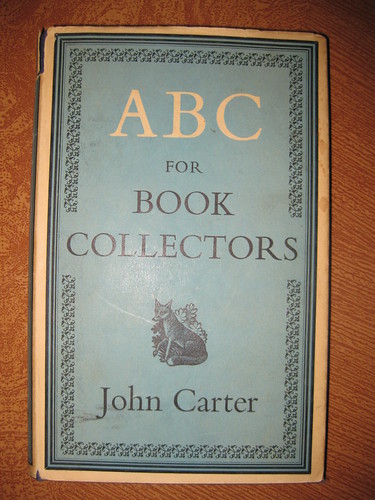
And I did buy one book for myself: a first edition of John Carter’s ABC for Book Collectors. They say every collector ought to have a copy and somehow I’d avoided getting one until now. This copy cost me less than a new copy of the latest edition would, and is still in beautiful, usable condition. Success!
Now all this said, I would go again because I have no alternatives. But there was a gloomy atmosphere at the fair this time around, a sense of impending doom. If this fair is going to survive, some changes need to be made. Or, perhaps, someone needs to pick up the slack and mount an event that’s more suited to a literary city of Toronto’s calibre. Anyone???
April 29, 2009
Aesthetic Books
My husband and I had a minor disagreement in a bookstore this weekend. We were browsing editions of Lord of the Rings for his collection, it being high time he replaced his mass market paperbacks with a “good” copy for long-term enjoyment. I was leaning towards the 1965 box set with the painted dust jackets, but he liked the look of the 1984 Easton Press leather bound edition with the lovely gilt elf-runes all over. Both have their place from a collectibility standpoint, but I prefer the books that reflect their original time and history, rather than fancy reprints. Having a library full of beautiful leather bound editions is certainly pretty, but I find it doesn’t capture the history and authenticity of individual books. I like my books to be cultural artifacts rather than art-works.
Of course, books as pretty things have their place too. Like, for instance, as purses.

This artist was recently featured on some US tv show or another and her work is gorgeous. Sadly she didn’t have a beautiful Three Musketeers or Count of Monte Cristo that I was willing to shell out for, so I found myself skimming Etsy for similar items. To my great delight, it seems there are several vendors who “upcycle” old books like this.
Thank you, clever artistic folk, for keeping me enthused about all the endless possibilities offered by books. You never cease to amaze me.
April 27, 2009
Travel: The Poetry of Motion
As I type this it is Monday: with any luck this will be posted before Tuesday though if I don’t manage to get it up in time let me extend my apologies for the delay and my thanks for your patience!
This month’s virtual exhibit, Travel: The Poetry of Motion, has been a good deal of fun to put together because though the subject is quite general, some interesting themes emerged as the literature presented itself. The history of travel literature is distinctly Western and often colonial, and the present is apologetic, reflective and surprisingly inward-looking – what will be the future, I wonder? When we’ve mapped all the places and normalized or done away with the concept of “foreign-ness”, what will remain? What will travelers of the future write home about?
April 24, 2009
Contest: The April Digital Book Collection
Well here we are again, on the last Friday of the month. And as promised, I have another virtual scavenger hunt on the offer!
What’s this? For a full explanation, check out last month’s post. But here’s the 50 cent spiel:
One per month Inklings will host a virtual book collecting contest. The object will be to build, virtually, a collection on a theme of my choosing. Our collective task will be to bring together images of books that we think belong in the collection. In order to submit a book to the collection you need only take a picture of it. You don’t have to own it but you do have to be able to take a picture of it – no Googled images allowed! Go out and look around; check bookstores, libraries, garage sales, museums, friends’ houses – anywhere! If you see a book that belongs in the collection, snap a photo of it and send it in to charlotte@once-and-future.com along with a short description of the book (title, author, publication date; that kind of thing) as well as a note on where you found the book and why you think it belongs in the collection.
On Monday I will compile all the submissions and present a virtual exhibition of our collection. The person who submits the “best” addition to the collection will receive a prize – this month, the prize is a book bag and bookmark from the Osborne Collection of Early Children’s Books. Please have your entries in to me by 6am on Monday, April 27th – in time for me to make my post on Monday!
The collection this month will be on the theme “Travel: The Poetry of Motion“. Why? For the entirely selfish reason that I have just obtained a new book for my own collection, below:
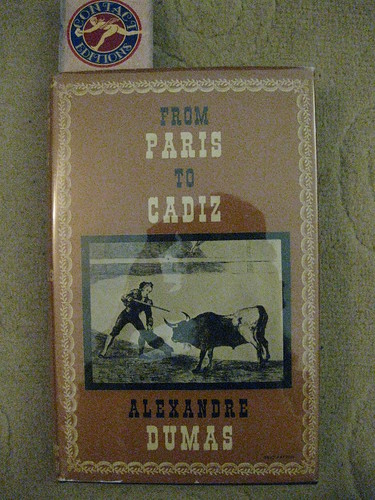
What? From Paris to Cadiz by Alexandre Dumas, Peter Owen Ltd., London, 1958
Found? At Contact Edition in Toronto, Ontario – though now it lives in my library.
Why? This is the first English translation of Alexandre Dumas’ voyages to Spain, considered the “high water mark” of his “Impressions de Voyages”. Dumas’ travel books are colourful, exciting and almost entirely non-fiction.
***
But be creative! There are many ways to approach the theme and I am partial to thinking outside the box. Here is a second example:
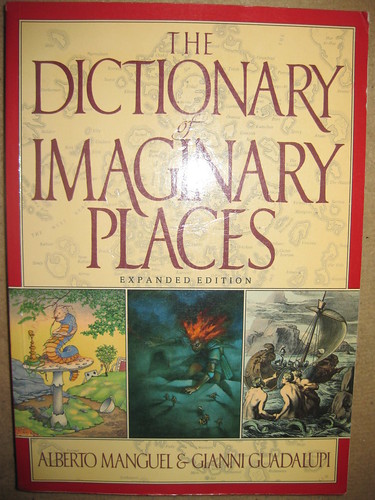
What? The Dictionary of Imaginary Places, Expanded Edition, by Alberto Manguel and Gianni Guadalupi, Lester & Orpen Dennys, Toronto, 1987
Found? In my dining room.
Why? The perfect atlas to all the places that never existed. The Dictionary includes extensive maps of fictional worlds as diverse as Tolkien’s Middle Earth and the Swiss Family Robinson’s New Switzerland. Plan your flights of imagination with this meticulous resource.
So good hunting! I will see you on Monday!
April 22, 2009
World’s Favourite Ass-Kicking, Sesquipedalian Librarian!
If you haven’t already, you have to check this out. Rex Libris by Toronto comic book artist James Turner.
Why?
– Reveals secret world of librarians and their daily struggle to protect civilization from forces of ignorant evil
– Circe vs Gaiseric, King of the Vandals
– Will please Thoth
– Bonus comic by Chester Brown feat. The Count of Monte Cristo
– Demon Samurai
I think I’ve made my case.
April 20, 2009
Abebooks as Bibliographical Tool
I recently had to compile a largish descriptive bibliography of my Alexandre Dumas collection and, being library-disabled due to having a new baby around, was a little short on bibliographical resources. The best books (Frank Wild Reed’s Bibliography of Alexandre Dumas, say) were rare and not the sort of things I could check out and take home. Shamefully, I wound up leaning heavily on abebooks.com instead. I felt that this was a bit like using Wikipedia for a history paper.
So imagine my great surprise when Nicholas Basbanes, that book collecting czar, referred to using abebooks.com as doing “due diligence” in his most recent blog post. He admits he has “more work to do” but nevertheless I was shocked that a collector (and academic) of his profile would turn to what is essentially the eBay of books to get a gist of his book’s bibliography. It made me wonder if I should reconsider abebooks’s legitimacy as a research tool.
Abebooks has a lot of things going for it. Almost every rare and used book seller ever lists at least a portion of their stock there. So while there is a real wild west of Dudes Selling Books Out Of Their Garage going on, some of the world’s most respectable booksellers also have a presence. A search might yield 150 results, but at least a few of those ought to be from reputable sellers whose research you can trust. The star rating system gives you an idea of who is reputable and who might not be, just as on eBay. You can certainly find the basics of your book on Abebooks: publication date, publisher, edition and binding. If you’re lucky, you’ll get a blurb of what the book is and why it is important.
But is that any use to anyone? I use Abebooks in order to identify books I already posses and to get inspiration as I rewrite my essay for the final draft. So the book is already in front of me – I already know the publisher and binding, and often the date and edition. What I am looking for is to contextualize my edition, to learn what editions came before and after, what might be unique to my edition, or the history of my edition. This information might be in a listing, but more often it isn’t. Further, there’s no guarantee that the information that is listed is correct. And worst, I suspect many sellers also use Abebooks to do their research, and so bad information tends to perpetuate itself as it is copied from listing to listing. Unlike Wikipedia, nobody corrects Abebooks listings. It is more like eBay in this regard -buyer beware.
It’s true that the quality of an Abebooks listing goes up with the price of the book. Someone hoping to sell a $25,000 book is going to be meticulous in their bibliographical description. Does that mean reliability increases with price? In my experience, absolutely not. Here are a couple example from my experience over the last year or so:
 “Due diligence” in the case of this book meant “should I let my daughter chew on this”. The Angry Moon by William Sleator is a beautiful children’s book, and mine is in great condition for a book that has been on a shelf for forty years. What does Abebooks tell me? Well, at the bottom end of the spectrum we have the following description from a five-star seller:
“Due diligence” in the case of this book meant “should I let my daughter chew on this”. The Angry Moon by William Sleator is a beautiful children’s book, and mine is in great condition for a book that has been on a shelf for forty years. What does Abebooks tell me? Well, at the bottom end of the spectrum we have the following description from a five-star seller:
Little Brown & Co (Juv Pap). Book Condition: Used – Acceptable. Former Library book. Shows definite wear, and perhaps considerable marking on inside. Price: US$ 42.65
No date or indication if this is the 1st edition. No real information, and what does “perhaps considerable marking on inside” mean? Is there or isn’t there considerable marking? That strikes me as being a really important point.
On the upper end of the scale we have the following:
Little Brown & Co. an Atlantic Monthly Press Book, Boston, 1970. Hardcover. Book Condition: Cover okay, contents good. Stated First Edition. Oversized. 45 pp, Blue hardcover. Pages clean & tight. Cover has a few stains, wear to corners (cardboard showing), slightly loose, but all pages sturdy. Though the cover is as described, the pages appear unread. From the copyright page: The original legend which suggested this story was first recorded by Dr. John R. Swanton in Bulletin 39 of the Bureau of American Ethnology, Tllingit Myths and Texts (1909). The illustrations are elaborations on original Tlingit motifs. Price: US$ 260.00
Now we know the date and edition, and a description of the book’s physical dimensions as well as its contents. But here’s an interesting thing: “Stated First Edition” means that the book says it is first edition, but the seller isn’t willing to flat out declare the book the a first edition. Publishers have been known to not omit the “First Edition” identification in subsequent editions or printings. In this book? Who knows? Nobody has bothered to find out if they’ve got a first edition for sure, despite the much higher price tag.
But this is still an inexpensive book. Here’s another, pricier example.
Le Vicomte de Bargelonne, Alexandre Dumas – Dufour et Mulat, Paris, 1851 Two quarto volumes (268 x 176 mm), havana half-roan, smooth spine tooled, red shagreen-cloth covers (contemporary binding). First illustrated edition, rare, with 58 engraved plates, including 2 steel-engraved frontispieces, by Philippoteaux and J. David. Price: US$ 3489.20
Sounds alright – right? Well, hard to say. The listing confuses me. What constitutes the “first illustrated edition” of this work is still up for debate – two 1851 editions exist (according to Frank Wild Reed, anyway), a Mulat et Boulanger with 58 engravings, and a Dufour et Mulat with 60 plates (35 in the first volume and 25 in the second). Which is this? The Darfour and Mulat ought to have 60, not 58 engravings, so is this the Mulat et Boulanger? For $3,500 I’d really like to know.
Of course, we all know that the internet makes a bad research tool, right? It’s just a shortcut, somewhere to get a starting-off point before we head in to a library. Yah, we all know. But I think it bears repeating again. The internet has a lot of content and some of it good, but we’re still not at that place where it replaces the old books.
April 17, 2009
Not-so-micro-review of Widdershins
I know I said I wasn’t interested in reviewing books, but I have to post something about Charles de Lint’s Widdershins and as much as it pains me to say so, there wasn’t enough to the book to draw out a longer post. So here we go with the review.
 Charles de Lint is an old favourite of mine, a writer who meant a lot to me in high school and who I can still read without flinching too much. I think Fantasy as a genre needs some defenders in literary circles and I had hoped that Widdershins would give me a little platform off which to launch a few rants about the lack of respect the speculative genres get. But Widdershins is not the book to hold as a case-in-point for Literary Fantasy.
Charles de Lint is an old favourite of mine, a writer who meant a lot to me in high school and who I can still read without flinching too much. I think Fantasy as a genre needs some defenders in literary circles and I had hoped that Widdershins would give me a little platform off which to launch a few rants about the lack of respect the speculative genres get. But Widdershins is not the book to hold as a case-in-point for Literary Fantasy.
For those of you who are unfamiliar with his work, Charles de Lint is best known for being the undisputed king of “urban” or “mythic” fantasy. This means his books take place in the “real” world, or one that looks just like it. The fantastic elements are usually gently treated, introduced in appropriate ways and used as metaphors for complex human issues like child abuse, addiction, art or domestic violence. Many of his books, especially the recent ones, take place in and around a city de Lint has created called Newford, and it is with Newford that my qualms begin.
By the time Widdershins was written, Newford has been the backdrop for one too many stories. At this point in de Lint’s career, nearly every character in the city has had a Close Encounter of the Spiritual Kind and they are all entangled in each other’s lives. Despite some backpedaling to explain why Newford is such a mythic hotspot (the spirit realm is closer to the human realm here, magic draws to magic, etc.) the supersaturation of magic has almost trivialized the device. The mystery and metaphor are lost when Newford crossed the line from “real city” to “magical world”. De Lint seems aware of this, and in his preface to the book he offers a sort of apology for coming back to these characters and this story again. But one last story needed to be resolved, he tells us. Fans demand it. So in essence, Widdershins is fan service.
I really wish he hadn’t. Or, at least, I wish I had given this one a miss. The first half of the book (almost 300 pages worth) is loaded down with exposition and back-plot explanations (“Oh yah, that’s Christiana, my brother’s shadow (see: Spirit In the Wires)” or “My sister was a dog and tried to kill me but now we’re cool (see: Onion Girl)…”) and the middle hundred pages are devoted to name-dropping every powerful and awe-inspiring character in the world. De Lint seems to be trying to call up an epic finale to his Newford books by invoking every power he created along the way, but the result of so many “big names” on screen is that they all seem trivialized.
The Big Issue he tackles (aside from Jilly’s abusive childhood, which he already dealt with better in Onion Girl) is a good one – the revenge of the native North American spirits against the invading European spirits (and humans). Restitution for what Europeans did to those who came before them is an entirely unresolved real-world issue that de Lint spins very sympathetically, but the actual plot resolution is weak and anticlimactic. I find it unlikely that hundreds of years worth of seething anger is likely to evaporate the way it did on-page. There’s a lost opportunity here that might have been better handled if it hadn’t been approached in a book that already had too much baggage.
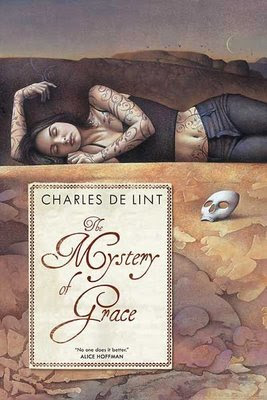 Now, on the positive side of things, there’s no evidence that de Lint has weakened as a writer at all. Widdershins reads like an ill-advised project, but he brings to it the same excellent storytelling and character building that he is known for. De Lint is not a “poetic” writer – I couldn’t find a good prose excerpt to demonstrate his great eloquence because that’s not really his thing. But, probably mindful of this, he doesn’t make any embarrassing attempts at high falutin and flowery imagery filled with misappropriated words and tired old cliches like some writers I could mention. He focuses where his strengths lie: dialogue, character building and action. His characters are so fully realized and unique that I can almost forgive him for coming back to them again and again. It’s hard to leave old friends.
Now, on the positive side of things, there’s no evidence that de Lint has weakened as a writer at all. Widdershins reads like an ill-advised project, but he brings to it the same excellent storytelling and character building that he is known for. De Lint is not a “poetic” writer – I couldn’t find a good prose excerpt to demonstrate his great eloquence because that’s not really his thing. But, probably mindful of this, he doesn’t make any embarrassing attempts at high falutin and flowery imagery filled with misappropriated words and tired old cliches like some writers I could mention. He focuses where his strengths lie: dialogue, character building and action. His characters are so fully realized and unique that I can almost forgive him for coming back to them again and again. It’s hard to leave old friends.
De Lint has a new novel out, The Mystery of Grace, which is entirely self-contained and free from Newford. With any luck this will bring out the best of de Lint’s appeal again. There is no reason why his books shouldn’t stand free of the usual criticisms lobbed at frivolous writers of genre books. He is as good a story teller as Guy Gavriel Kay and Neil Gaiman, both of whom seem to enjoy some mainstream appeal these days. Perhaps I can revisit de Lint later this year and present a review which will stand as a better defense of the genre than the unfortunate Widdershins.
April 14, 2009
Another One Bites the Dust
Librairie Champlain, the only real french bookstore in Toronto (Maison de la Press in Yorkville sells some books as well, but specializes primarily in magazines), is closing up shop at the end of the month.
There has been a lot of press lately about the resilience of independent bookstores, citing the sprinkling of new shops which have opened in Toronto in the last few years – Type, The Monkey’s Paw, Re: Reading, Circus and of course, the new McNally Robinson store to name a few almost all of them. I’m on the fence about whether the overall shape of Toronto independents is good or bad. It certainly is heartening to see all the new stores. But they aren’t replacing the old ones. What’s being lost is the specialty stores – David Mirvish Books on Art, Champlain and Ballenford Books on Architecture (to name three of this year’s casualties) were old stores with very deep, specialized knowledge of their product. As cool as the new stores may be, with the exception of Monkey’s Paw, they basically sell more of the same thing everyone sells.
I also wonder how long they will last. None of the new stores are more than three years old. Will they go the distance? Or are we still floating on the new owners’ optimism and capital?
Anyway, it is sad to see another great old shop felled by, largely, online competition. Buying books is a political act, kids. Shop ethically.
April 13, 2009
Some Egg-Related Fun For Today…
The Easter Bunny visited our house and left nothing, but stole all of my free time. So in place of a post today, I offer you a diversion. In honour of National Library Week (in the USA), Oxford University Press is offering free access to their massive online reference collection, the Oxford Reference Online (ORO) database. And to kick it off, they’re hosting a scavenger hunt!
Hunting information beats hunting eggs 9/10, 10/10 if you already have chocolate at home.
April 10, 2009
Pot tells kettle to get a new editor!
Yah, I know. I don’t always produce the most polished product myself. I can’t spell and I still confuse the possessive of “it” from time to time and I’m very fond of run-on sentences. But you don’t pay to be here and nobody paid me to show up either, and most importantly, I don’t have an editor who is responsible for making me look more thorough than I am.
People who publish books do not have that excuse. They have, I am told, editors. Someone is paid a salary to make sure that the book which is produced from the manuscript is clean, coherent and is written in proper English. Nevertheless I have seen more bad grammar, continuity errors and puzzling editorial choices in the last year’s reading than I think I have seen before in my life. It could be, yes, that I am simply becoming a more careful reader. I don’t want to imply that there’s a conspiracy of incompetence out there amongst editors. Maybe I do want to appeal for an editorial job with a big publisher though. I’m happy to proofread for any of you. My services are very cheap.
It started early last year with a book of questionable quality from a big pulp publisher. I won’t call it out by name because I don’t want to admit that I read it. To give you an example of the kind of writing the author got away with, I give you the following:
“His hands trembled as he laid out the service; Laurence dismissed him once the meal was served and sighed a little when he had gone; he had thought of asking Giles to come along with him, as he supposed even an aviator might have a servant, but there was no use if the man was spooked by the creatures.”
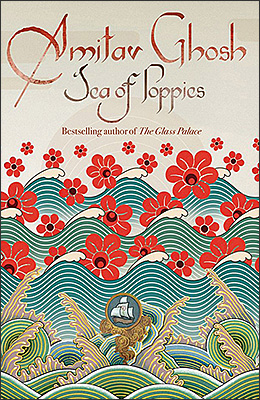 At the time I was absolutely shocked that a sentence like this could make it to print. Semicolons are not periods, I thought that was pretty obvious. And yet, later that year I found a similar, though not as grievous, mess in Amitav Ghosh’s Sea of Poppies. And this book was shortlisted for the Booker! Four of the seven sentences on the very first page (of the Viking hardcover I read) contain “colon splices”, inexplicable colons appending one thought to the previous. Witness the first line:
At the time I was absolutely shocked that a sentence like this could make it to print. Semicolons are not periods, I thought that was pretty obvious. And yet, later that year I found a similar, though not as grievous, mess in Amitav Ghosh’s Sea of Poppies. And this book was shortlisted for the Booker! Four of the seven sentences on the very first page (of the Viking hardcover I read) contain “colon splices”, inexplicable colons appending one thought to the previous. Witness the first line:
The vision of a tall-masted ship, at sail on the ocean, came to Deeti on an otherwise ordinary day, but she knew instantly that the apparition was a sign of destiny, for she had never seen such a vessel before, not even in a dream: how could she have, living as she did in northern Bihar, four hundred miles from the coast?
Colons aren’t periods either. Are they? An occasional sentence like the above would be forgivable, poetic even: but almost every one in the book is structured this way!
 I’ve decided to forgive Neil Stephenson’s editors for Anathem. I was puzzled at first as to why, on page 739, a meeting in a super-secret Cell is suddenly interrupted by a character who is not there and has not been seen for several hundred pages. In hindsight, one error (however glaring) in 935 pages is probably not bad, especially when so many of those pages are taken up with arcane mathematical theorics. But (she says, hoping someone from William Morrow is reading) I noticed it. My services as a proofreader are still on offer.
I’ve decided to forgive Neil Stephenson’s editors for Anathem. I was puzzled at first as to why, on page 739, a meeting in a super-secret Cell is suddenly interrupted by a character who is not there and has not been seen for several hundred pages. In hindsight, one error (however glaring) in 935 pages is probably not bad, especially when so many of those pages are taken up with arcane mathematical theorics. But (she says, hoping someone from William Morrow is reading) I noticed it. My services as a proofreader are still on offer.
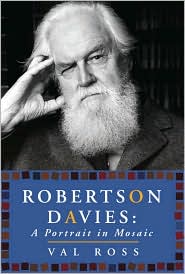
I mentioned my editing concerns in a private blog last year and was told by one friend that the grammar I was complaining of is deliberate, and is what english and publishing students are taught nowadays. Really? To what end? Where is the cost saving here?
